MONDAY
NOVEMBER 26 - 2018
Brook
Meadow
A couple of
things got my attention as I walked round the meadow
on this fine and chilly morning. Firstly, the two
young Oak trees on the Seagull Lane patch that retain
their brown leaves over winter were looking quite
magnificent. The first tree was planted about 10 years
ago by Jenny Smith in memory of her husband and is now
a substantial size.

The other one, much
smaller, was planted by me during the Jubilee
celebrations in 2012.

Interestingly, the Oak
tree planted by the Mayor of Havant on the same
occasion has shed all its leaves, as has the tall Red
Oak planted in memory of Tony Wilkinson. Most Oak
trees lose their leaves in winter, but some like the
two on this site, retain theirs. This is called
marcescence which also affects Beech.
Apparently, it does not harm the tree and may provide
an advantage in the early years of the tree's growth
in making it less palatable to browsing animals.
Regarding leaves it is
also interesting that the Crack Willows on the meadow
lose their leaves quite early in autumn, while the
Osiers and the Goat Willows keep their well into
winter. Here are some Osier leaves on the east side of
the north meadow.

Also of interest is
the continued late flowering of both Hogweed and Wild
Angelica
Note the tiny flecks of pink in the Hogweed flowers on
the left
Also flowering well is
Meadowsweet which seems to go on and on.

It was also good to
see the first Winter Heliotrope of the winter on the
river bank
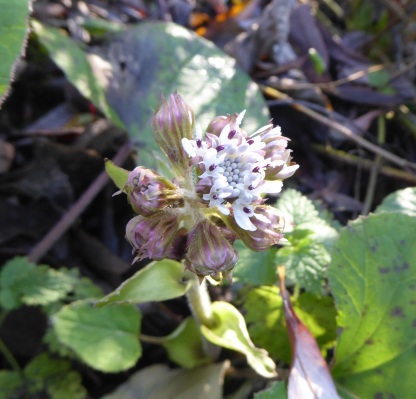
Emsworth
to Warblington
Peter
Milinets-Raby explored the shore from Emsworth to
Warblington on a bright and sunny morning with a
chilly wind. 9:05am to 11:34am tide out, then pushing
in.
Beacon Square: 13
Wigeon, 117 Brent Geese, 2 Shelduck, 7 Teal, 3 Pied
Wagtails in the back gardens (see photo).

Emsworth Harbour: 153
Dunlin, 32 Black-tailed Godwit, 13 Grey Plover, 5
Turnstone, 7 Red Breasted Merganser, 1 Great
Black-backed Gull, 5 Lapwing, 177 Brent Geese, 1
Kingfisher. 1 Sandwich Tern perched on a buoy. I
bumped into one of your many website readers (lives
locally by the pond) and said "Hello" and showed her
the Sandwich Tern through the scope). 19 Coot, 16
Teal, 1 Rock Pipit on the seaweed covered slipway for
a few minutes between dog walkers. 1 Shelduck, 5
Little Grebe.
The birds of the
morning were a family group of 5 Goosanders
(one female and four juvenile birds). The female was
rushing about feeding, whilst the other four birds
just kept following. They were in the shallow stream
mouth by the town wall, before they swam up the narrow
channel into the Emsworth/Thorney Yacht marina to no
doubt give someone on a yacht some stunning
views!
Mill Pond: 23 Coot, 1
Little Grebe.
Nore Barn: 1 Spotted
Redshank and 1 Greenshank (G//R + GL//-) in the
stream, 126 Brent Geese, 141 Wigeon, 49 Teal, Skylark
over calling, 22 Black-tailed Godwit, 1 male and 6
female Pintail, 2 Shelduck.
Conigar Point: 99
Wigeon, 254 Brent Geese, 1 female Pintail, 5 Teal, 24
Shelduck,
The lone Canada Goose
was on the shore this morning. 1 singing Chiffchaff in
the Tamarisk Hedge, 1 Sandwich Tern fishing along the
channel, Skylark heard flying over, 2 Red Breasted
Merganser, 34 Grey Plover resting on the last bits of
mud before flying off to roost with 55 Dunlin.
Off Pook Lane: 91
Wigeon, 10 Lapwing, 5 Red Breasted Merganser, 75 Teal,
219 Brent Geese, 15 Shelduck, 3 Sandwich Tern resting
on buoys, 1 Great Crested Grebe (still with some
summer plumage - see photo).

Finally 15 Curlew in
the field next to Castle Farm barn.
SUNDAY
NOVEMBER 25 - 2018
Garden
wildlife
I have had
quite an interesting day watching birds and other
wildlife in my back garden. The highlight was
undoubtedly a Kingfisher which I just happened
to spot perched on the wall at the end of the garden
at lunchtime. It was whacking a fish onto the wall to
stun it. This wall overlooks the Westbrook Stream,
which flows behind the gardens down to the town
millpond and has plenty of fish which attract
Kingfisher as well as other birds, such as, Little
Egret and Grey Wagtail. This was only my 8th record of
a Kingfisher in the garden, so I was really cuffed.
Previous sightings were: 14-Mar-05, 22-May-06,
25-Nov-07, 16-Dec-07, 02-Jan-08, 03-Feb-13, 09-Nov-14.
Sadly, I did not get my camera out in time for a
photo, but I have included below the one and only
photo of a Kingfisher I have managed to capture on the
wall in November 2007.
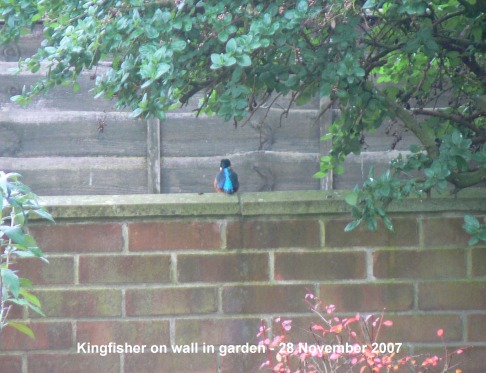
Another welcome
visitor to the garden over the past week or two has
been a female Great Spotted Woodpecker which
spends several minutes poking at seeds through the
mesh of one of my newest holders. Generally, I get one
and sometimes two Great Spotted Woodpeckers on the
seedholders fairly regularly during the winter months.
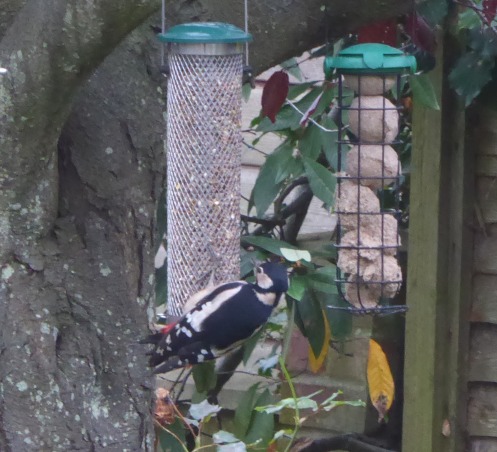
The following photo of
a Great Tit on a seedholder shows the dried
mealworms that I now include in the feeders
along with sunflower hearts and the regular seed mix.
I have tried putting them in a separate 'mealworm
feeder' but they are then rapidly consumed by flocks
of Starlings.
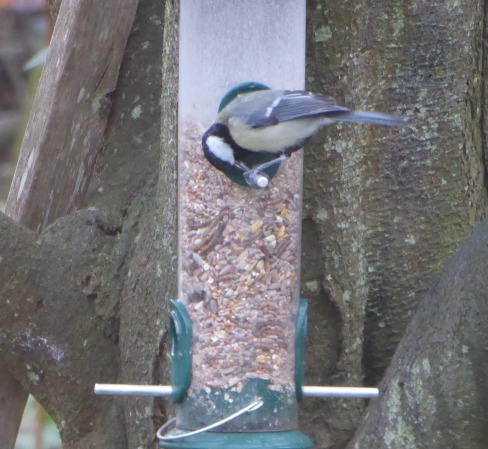
Less welcome visitors
are the White Doves up to 5 of which regularly
descend into the garden. These birds are not wild and
presumably belong to a local dovecote. In fact, they
are very tame and I can walk right up to them without
them moving, so they are not easily shooed away!
However, they do a good job in mopping up the seed
droppings from the main feeding station in the tree. I
often see them on the roof of St James Church which
can easily be seen from my garden. As they are not
wild they cannot not included in my BTO Garden
BirdWatch entries.
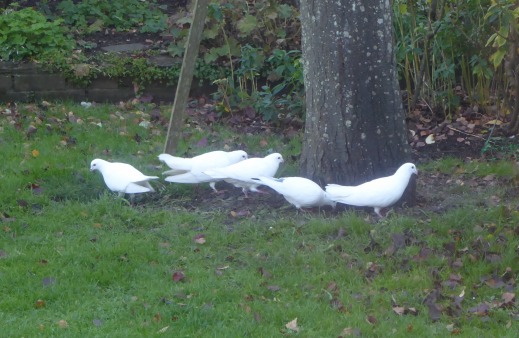
Another regular
visitor is the Grey Squirrel. One, and
sometimes two, often arrive to gnaw away at one of the
seedholders. I had to replace the original plastic
holders with metal ones which are able to resist the
Squirrel's sharp teeth. However, I have given up
trying to discourage what are a remarkably clever and
agile creatures and now I just sit back and enjoy
their antics. Here is one I snapped today stealing
mixed seeds.
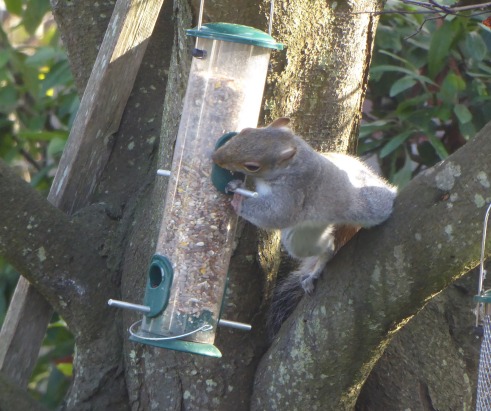
FRIDAY
NOVEMBER 23 - 2018
Emsworth
to Langstone
Peter
Milinets-Raby gives a summary of three birdwatching
visits this week, all at high tide, which is never a
good time for waders etc. All visits are roughly
between 9am and 11am.
Monday 19th:
Off Conigar Point: 1 Canada Goose, 42 Shelduck, 75
Wigeon, 6 Sandwich Tern feeding along the channel, 2
Great Crested Grebes, 1 adult Med Gull flew inland, 1
Seal seen, 1 Chiffchaff in the Tamarisk Hedge.
Pook Lane: 104 Bar-tailed Godwit resting on the last
bit of the island in the middle of the channel before
departing to roost, 29 Grey Plover also, 100+ Dunlin,
4 Goldcrest together along track.
Wednesday 21st:
Warblington Ibis Field: 1 Chiffchaff, 1 Green
Sandpiper.
A mobile flock of 73 Linnet (counted from photos) in
the stubble field behind Conigar Point with 5 Skylark
and 26 Stock Doves. 33 Curlew in the field next door.
1 Canada Goose feeding in the stubble field (see
photo).

Friday 23rd:
Beacon Square: 275+ Dunlin on last bit of salt
marsh mud with 5 Turnstone, 1 Ringed Plover and 4 Grey
Plover.
Emsworth Harbour: 10 Little Grebes, 8 Sandwich Tern
resting on buoys, 1 Peregrine perched on one of the
red channel marker posts.
Emsworth Mill Pond: 1 Little Grebe.
Warblington Ibis Field: Water Rail heard. Chiffchaff
heard, 2 Goldcrest, 1 Canada Goose still in the
stubble field behind Conigar Point.
Conigar Point: Amazing sight of 36 Cormorants feeding
in a tight flock with just their necks above the
water!
Langstone Mill Pond: Just 24 Teal, but a nice handsome
male Shoveler. 1 singing Mistle Thrush. 3 Sandwich
Terns resting on buoys in the channel.
THURSDAY
NOVEMBER 22 - 2018
Bridge
Road Wayside cut
Walking out
this morning, I was delighted to see that the Bridge
Road wayside had been cut and a good job too. This
followed my discussion with George, of the Norse
cutting team, a couple of weeks ago, about putting the
wayside back on the regular cutting schedule. So, they
have done it.

I have written to
Graham Palmer, the Norse cutting manager, to thank him
for putting the wayside back on the regular cutting
schedule. This late autumn cut should benefit the
early spring flowers like Lesser Celandines and
Cuckooflowers which normally abound on this wayside
though they have been overcome in the past couple of
years by excessive growth.
I will check on the date of the next cut - probably
early summer?
Millpond
News
There was
nothing of special interest on the town millpond where
the Mute Swan pair continue to reign supreme.

Down on Slipper
Millpond I found the resident Mute Swan family of mum
and 3 cygnets looking very well.

Brook
Meadow
I walked home
through the meadow and took a few photos of the fine
views. This is looking north from the Lumley gate.

I also stopped to
admire the continuing clearance of the river bank by
the north bridge - by volunteers Dan and Terry. They
doing a good job in preparing the habitat for any
possible return of Water Voles.

Avocets
at Nutbourne
Yesterday,
Anne de Potier found another sign of winter with the
welcome presence of 46 Avocets in Nutbourne Bay. Anne
did not get a photo, but here is one of a few Avocets
on the shore at Nutbourne taken by Trevor Carpenter a
few years ago.

MONDAY
NOVEMBER 19 - 2018
Nore
Barn
I had a quick
look at Nore Barn late this morning. The tide was too
low for the Spotted Redshank, but there was a good
variety of birds were using the lower reaches of the
stream including Wigeon, Teal and Black-tailed
Godwits. The regular Brent Goose family with one
juvenile was also present.

There was another
small flock of Brent Geese on the green mudflats, but
no juveniles that I could see.
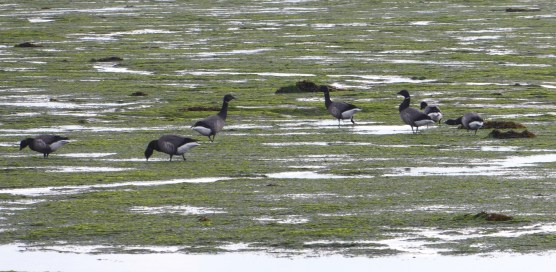
SATURDAY
NOVEMBER 17 - 2018
Emsworth
Harbour
Peter
Milinets-Raby had his first November visit to the
Emsworth shore this morning - 7:47am to 9:37am - high
tide, but going out eventually. Here's his report.
Beacon Square: 3 Shelduck, 12 Grey Plover, 9
Turnstone, 137 Dunlin, 35 Brent Geese.
Emsworth Harbour: 1 Kingfisher perched on the
sea wall, 6 Sandwich Tern feeding and loitering on
marker posts, 7 Coot, 124 Brent Geese, 5 Little
Grebes, 20 Black-tailed Godwit along the shore by the
town wall along with 3 Greenshank and 7 Lapwing. 1 Red
Breasted Merganser, 8 Shelduck, 15 Grey Plover, 102
Dunlin, 8 Turnstone.
Two flocks of Canada Geese flew low east - A flock of
16, then 29.
Emsworth Millpond: - 25 Coot.
Nore Barn: From 8:36am: 134 Brent Geese -
several juveniles around - see photo of youngster
eating his greens, being watched by his mum!!.

1 male and 6 female
Pintail (looked like a family group), 25 Teal, 94
Wigeon, 1 Grey Plover.
1 Peregrine flew over and headed east into Emsworth
Harbour where it dashed around chasing
Dunlin.
And I said "Hello" to
Scotty, Sebastian, Shaun, Scarlett, Sharlene or Stacey
(Take your pick) - It hid behind one of the big rocks
in the mouth of the stream as the Peregrine flew over,
before eventually coming out and showing off nicely in
an elegant Sophie-like way!! See photo of Sophie The
Spotted Redshank hiding then coming out when the coast
was clear.
With the prospect of
cold weather soon, Peter has a feeling that something
good might turn up! His HOT List (or "Cold List") are
species like: Pochard, Scaup and Smew
Brian's
comment: Out of the names suggested by Peter my
preference is for Sebastian - a strong name for a
tough and resourceful bird. Also, I am also pretty
sure the Spotted Redshank is a male as it always
arrives later than the flighty females which pass
through in Aug/Sep.
BTO
Bird Trends
Every year BTO
summarises the information they have gathered about
the population status of the UK's common breeding
birds in the BTO/JNCC Bird Trends report. Bird Trends
2018 has just been published and shows that there are
26 species which show population declines of greater
than 50% - see . . . https://bto-enews.org/IG4-5Z0IF-3RN36S-3D85NF-0/c.aspx
and 23 species which show a doubling in population
size over the longer term - see . . . https://bto-enews.org/IG4-5Z0IF-3RN36S-3D85NG-0/c.aspx
Greenfinch
and Swift in trouble
Based on their
population trends over recent years, both Swift and
Greenfinch could be new candidates for inclusion on
the next Red List of birds of the highest conservation
concern. Both Swift and Greenfinch show worrying
population declines over recent years. See . . .
https://bto-enews.org/IG4-5Z0IF-3RN36S-3DBHLX-0/c.aspx
This is no surprise to
me as both these birds used to be regular visitors to
our garden here in Emsworth, but they are now
rarities. The following chart shows clearly how
Greenfinch numbers in my garden here in Emsworth have
plummeted since 2006 due mainly to disease. I have not
calculated this year's totals, but they are not likely
to be any better.
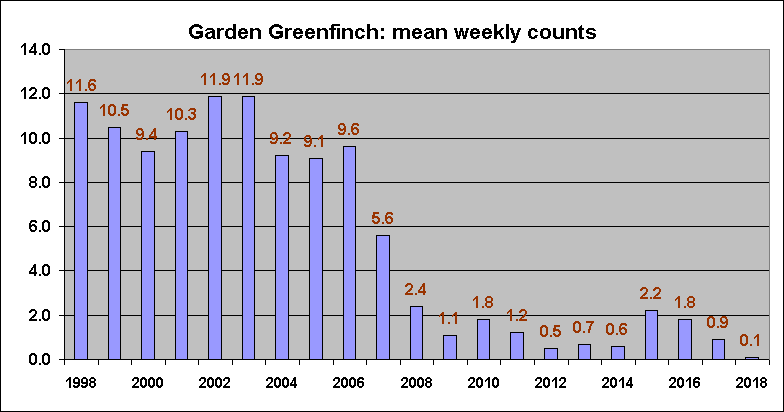
THURSDAY
NOVEMBER 15 - 2018
Brook
Meadow workday
There was a
very good turn out of volunteers for the work session
on this dull but mild autumn morning. I counted 16 in
the group photo though others joined later.

Colin Brotherston
outlined the main tasks which kept the volunteers very
busy. They were:
1. finish cutting
and clearing the south east corner of the south
meadow,

2. start cutting and
clearing the southern section of the south meadow,

3. continue clearing
of vegetation from the river bank south of the north
bridge

Other jobs: cutting
scallops along the Bramble path on the east side of
the south meadow, remove an overhanging branch from
above the southern signcase, lop damaged tree branches
on the east side of the north meadow, litter
picking.
Wildlife
observations -
It was good to see the first pale Hazel catkins
on the bush above the north bridge - contrasting
nicely with the bright orangey coloured leaves.
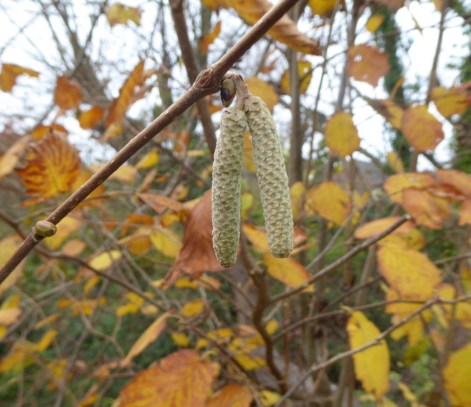
Kathy pointed out some
interesting fungi growing on an old Willow log beside
the south path. I have tentatively identified them as
follows: Grey Polypore which is a fairly common
fungus growing in tiers on dead wood

and Bonnet Bell
Cap which again grows in clusters on fallen
logs.
During the clearance
of the south east corner volunteers reported an
aniseed smell, which suggested Fennel. There is an old
record of Fennel on the Brook Meadow list, but it has
not been seen for many years, so I removed it from the
list. However, I will keep a look out in the spring.
WEDNESDAY
NOVEMBER 14 - 2018
Nore
Barn
I called in at
Nore Barn on the way home from my morning's stewarding
at the Pallant Gallery. The Spotted Redshank was right
at the top of the stream near the bridge - I don't
recall having seen it quite that far before. It moved
off when people started walking over the bridge, but
it remains an extraordinarily tame bird.
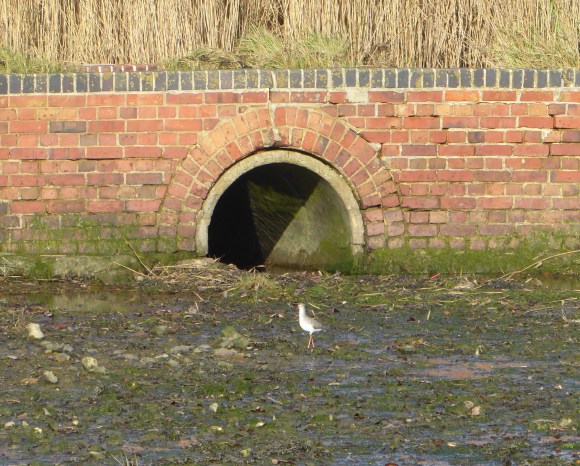
Here is the Spotted
Redshank feeding in the running stream. Its regular
feeding companion the colour-ringed Greenshank (G+GL)
was not there today.
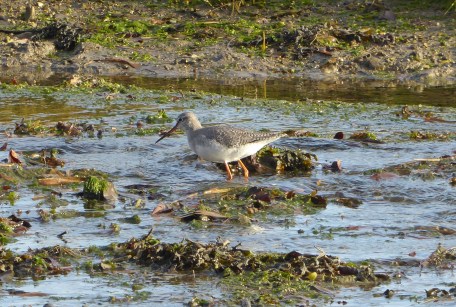
For
the full history of the Spotted Redshank at Nore Barn
see . . .
Spotted
Redshanks at Nore Barn
There was a good flock of Wigeon in the bay

The Brent Goose family
with 1 juvenile that I saw on Monday was also present.
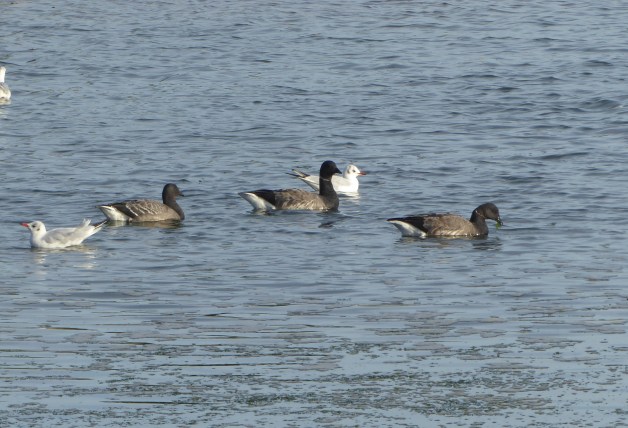
TUESDAY
NOVEMBER 13 - 2018
Brook
Meadow
I had a walk
through the meadow on a very warm and pleasant autumn
morning. How beautiful everything looked. Here are
some shots of the path and the river through Palmer's
Road Copse.

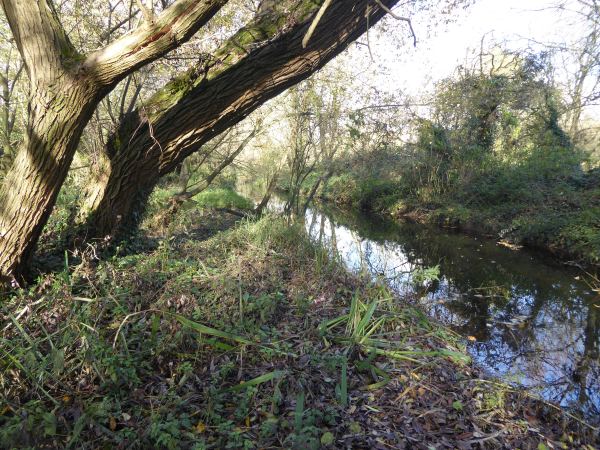
The trunks of fallen
Willow trees were clothed in bright green feather
mosses.
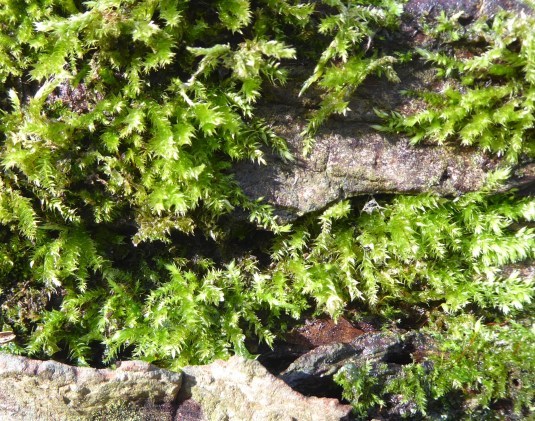
A single plant of
Gipsywort was still standing on the river bank.

I noticed a pair of
Common Darters flying in tandem over the river. Mating
in November! No photos alas.
MONDAY
NOVEMBER 12 - 2018
Nore
Barn
It was a
bright but stormy morning with dark clouds
threatening, but I had to get over to Nore Barn to
check out my friend. Excellent news, the Spotted
Redshank was in the stream with its regular
feeding companion the colour-ringed Greenshank
(G+GL). Both were rushing around actively feeding
- there must be a good supply of food. I managed to
get some photos and a video despite the strong winds.
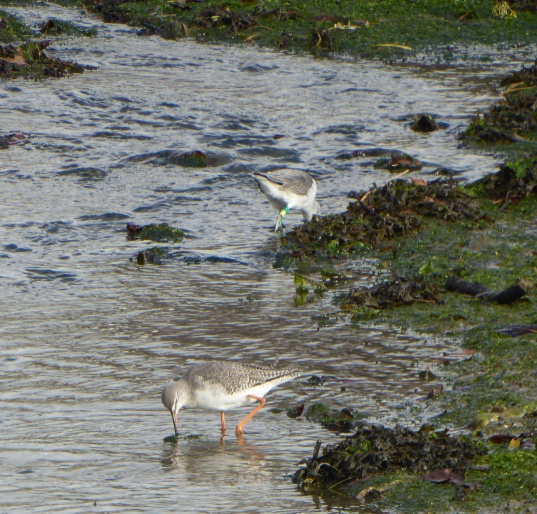
Video
clip of the two birds in the
stream . . .
https://youtu.be/c5bk4YepZDg
Also in the stream,
having a good wash and brush up, was a Rock
Pipit. After its bath it went up onto the grassy
bank to dry off
A small flock of
around 30 Black-tailed Godwits was roosting on
the edge of the saltmarshes. With the tide rising fast
I suspect they will not be there for long. No chance
of getting any colour-rings. The photo shows just a
few of them with a Black-headed Gull keeping company.

I had a walk round the
woods, but did not see anything of interest. When I
got back to the stream at about 12 noon a group of 6
Brent Geese were in the stream area, including
a family of two adults and one youngster - my
first juvenile of the winter. The juvenile is in the
middle in the photo with white bars on its wings and
no white neck band. It is much too early to predict
breeding success, but the signs are a bit ominous.

Langstone
Mill Pond
Peter
Milinets-Raby visited Langstone Mill Pond this morning
from 9am to 10:22am - low tide.
Off shore: 127 black-tailed Godwit, 1 Knot, 18 Grey
Plover, 36 Dunlin, 204 Brent Geese, 50 Shelduck, 22
Bar-tailed Godwit , 5 roosting Sandwich Tern, 5 Common
Gulls, 1 adult winter Med Gull, 1 Wigeon - none around
this morning - probably disturbed early morning???
1 Great Crested Grebe, 31 Lapwing, 11 Red Breasted
Merganser, 1 Greenshank (usual bird G///R + BR//- This
one should really be named, like Gregory, Gerald or if
a girl, Gabriella, Giselle or my favourite Gwendolyn
the Greenshank).
Brian's
note: Here is a photo of the Greenshank taken by Peter
in 2014
I like the name Gabriella (if a girl) as it fits the
colour ring combination G+BR
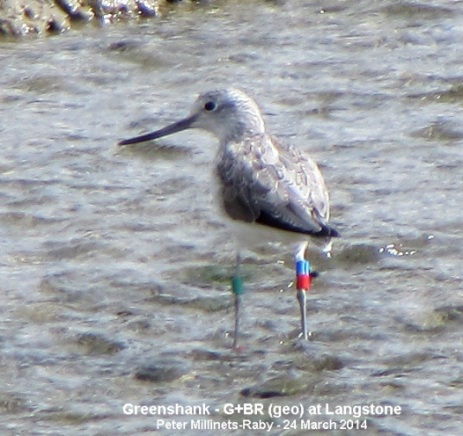
Langstone Mill Pond:
Devoid of Teal. Cetti's Warbler heard briefly singing
the once, Reed Bunting heard calling, then seen flying
off high west.
Flooded Horse Paddock: This is where all the Teal
went, 67 counted along with 23 Mallard, 7 Moorhen, a
Grey Wagtail and a Meadow Pipit
PLANNING
FOR BIODIVERSITY
From Ray
Cobbett of the Havant Friends of the Earth Environment
Group
"You
are invited to an open meeting on 27th November at 7
pm at the United Reformed Church Meeting Place, Elm
Lane, Havant where Dr David Rumble from Hampshire
Wildlife Trust will talk about Planning for
Biodiversity in Havant Borough. Admission Free".
Havant Council published a Biodiversity Action Plan
(BAP) in 2011.
http://www.havantfoe.org.uk/wp-content/uploads/Havant-Borough-Council-Havant-Biodiversity-Action-Plan-2011.pdf
With changes to
planning legislation since 2011 as well as local
changes on the ground plus an emerging Local Plan,
Havant Council has been urged to update the BAP
preferably with the involvement of local
conservationists coming forward with their ideas.
Havant Council have said there is not enough time for
public engagement at this time and are currently
proceeding with an update which is expected to be
published with the pre- submission version of the
Local Plan in January An opinion survey has been
commissioned by a group of local environmentalist and
so far almost 600 residents have responded. It is
intended to present the results at the meeting and to
the council.
Link to survey . . . http://www.havantfoe.org.uk/havant-borough-natural-environment-survey/
FRIDAY
NOVEMBER 9 - 2018
Langstone
Mill Pond
Peter
Milinets-Raby ventured down to Langstone Mill Pond
this morning ahead of the incoming tide (9:03am to
10:55am).
Off shore as the tide rushed in: 45 Dunlin, 17 Grey
Plover, 28 Black-tailed Godwit, 12 Sandwich Tern
resting on the mud, 19 Red Breasted Mergansers out in
the channel, 11 Common Gull, 157 Brent Geese (again
just the one juvenile), 32 Wigeon, A nice feeding
flock of 126 Bar-tailed Godwit with 2 Knot in amongst
them. They temporarily roosted on the island out in
the middle of the channel before flying off. 6
Greenshank (RG//- + YY//- and NR//- + YY//- and G//R +
BR//-), 4 Canada Geese, 45 Shelduck, 10 Lapwing, 2
Great Black-backed Gulls.
On Langstone Mill Pond: 33 Teal.
On the flooded paddock: 4 Teal, 1 Little Egret and 1
Grey Heron, 1 Buzzard perched on a fence post.
Off Conigar Point in the distance: 20 Shelduck, 101
Brent Geese, 10 Wigeon.
TUESDAY
NOVEMBER 6 - 2018
Nore
Barn
I drove over
to Nore Barn by 13.30 just in time to catch the
falling tide. The stream was emptying fast and the
Spotted Redshank was already ensconced and
feeding actively. No sign of the Greenshank (G+GL)
today. Also in the stream area was a group of around
20 Wigeon and a couple of Black-tailed Godwits.
A few minutes later
more Black-tailed Godwits arrived swelling the total
to 23 birds. They included three 'old friends' -
ROL+RLR, W+WN and R+GL - all of which have been
visiting Emsworth Harbour for many years. Details
follow:
ROL+RLR - I was
delighted to see this bird again with three colourful
rings on each leg. Despite their bright colours, the
rings are not all that easy to pick up, as the top
ones frequently disappear into the feathers of the
birds underside and the combination can be misread.
However, I have no doubt this bird was our old friend
ROL+RLR which has been visiting us in Emsworth Harbour
regularly every winter since October 2009. Today's was
my 105th sighting of this bird. It was originally
ringed on 27-Oct-08 at Kingsnorth Power Station,
Medway Est. Kent as an adult male which makes it at
least 11 years old. I suspect the migration route from
its breeding grounds in Iceland takes it down the east
coast of England, stopping off in Kent where it has
often been seen by Dudley & Carol Hird on the
Medway, before moving on to Emsworth for the rest of
the winter period.

W+WN - I did not
get a particularly good photo of this bird, though I
saw its rings clearly through my scope. It was
originally ringed on 05-Sep-10 by Pete Potts and his
team at Farlington Marshes. W+WN has been a regular
wintering bird in Emsworth Harbour since that date and
this was my 69th sighting. I last saw it on 01-Nov-17
- my only sighting last winter, though I did
relatively little Godwit recording last winter.

R+GL - I first saw
this godwit on 10-Sep 2010. It is a Farlington Marshes
bird, but I don't have the details of its ringing,
though I suspect it was in 2010. This was my 39th
record of R+GL, though some of these sightings were
made by other observers. The last sighting I have on
record was on 18-Nov-17 by Peter Milinets-Raby at Nore
Barn. As far as I am aware there were no further
sightings of it in Emsworth last winter, which
suggests it moves on elsewhere. It will be interesting
to see what happens this winter.

MONDAY
NOVEMBER 5 - 2018
Unusual
Heron tactics
Mike Wells had
an interesting sighting at Petersfield Lake this
morning. He was hoping to see a Great White Egret
which has been spotted several times over the last
week. No luck on that, but he did see a Grey Heron
behaving unusually in deep water. Mike saw it catch
two small fish and assumed it was special fishing
tactics for deeper water - not (sadly) the first
Short-Legged Grey Heron! Has anyone else seen this
sort of Heron behaviour?

SUNDAY
NOVEMBER 4 - 2018
Brook
Meadow
I went over to
the meadow by 10am this morning for the regular 1st
Sunday in the month work session. Eight volunteers,
attended on a mild and pleasant autumn morning.
Newcomer Diana joined later. Jennifer introduced the
main jobs:

Finish clearing the
orchid area on the north meadow which was cut last
time

Cut the south east
corner of the south meadow.
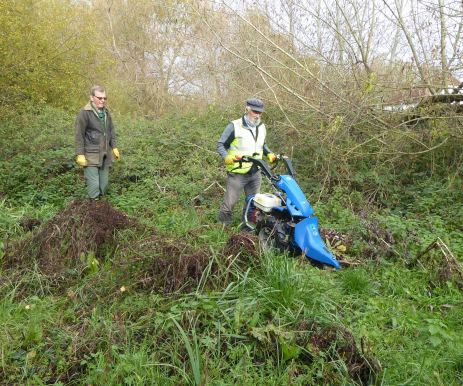
Hessian bags of soil
with Common Reed rhizomes
were positioned on the river bank near the north
bridge.
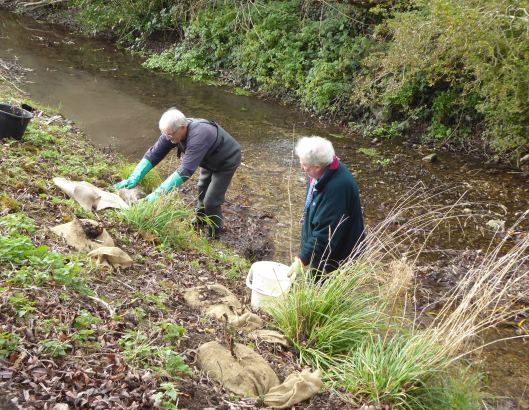
Wildlife
observations
I had a look at some of the Ash trees on
the site for any signs of Ash die-back. The very large
Ash tree on the railway embankment which overhangs the
north path looks a little sad with no leaves and
rather wizened seed cases - see photo.
One of the younger self seeded Ash saplings on the
north path also looks unhealthy with dead crinkled up
leaves. But the disease should be easier to identify
in the spring when new leaves should grow.

The Aspen tree
growing on the edge of the copse on the east side of
the north meadow currently has beautiful yellow
leaves, which shiver and rustle in the breeze.

Nearby, the Rowan
berries which were so prolific a few weeks ago
have now mostly been stripped by local birds. While I
was there a pair of Blackbirds came to help themselves
to some of the remaining berries. It will be good to
have a path right round the plantation. This is
planned for a future workday.

The self-seeded
Alder sapling in the middle of the Lumley area
is looking healthy.
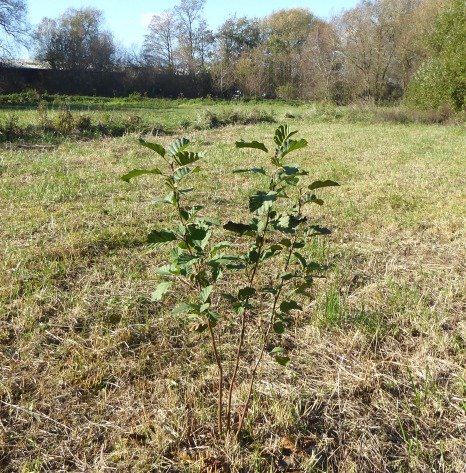
A Buzzard was
briefly flying over the Seagull Lane patch at the
start of the work session. I spotted a Red Admiral
flying near the Rowans and a Sparrowhawk flew over
Lumley copse.
News
from Cuba
Malcolm
Phillips sent a couple of photos taken at his new home
in Cuba, neither of which I am able to identify. Any
offers?
Garden
bird migration
The BTO report
that October is one of the peak migration periods,
when huge numbers of birds are on the move, including
some of our common garden birds. Dunnocks have been
recorded moving between Norway and the English south
coast. And Blue Tits from Scandinavia periodically
irrupt in amazing numbers as they head south to avoid
the harsh continental winter. See a video clip of such
an event at Nabben Nature Reserve at Falsterbo on the
west coast of Sweden when an astonishing 21,660 Blue
Tits were counted on migration . . https://bto-enews.org/NXK-5XI1A-3UEDCR-3C7J5J-0/c.aspx
FRIDAY
NOVEMBER 3 - 2018
Thorney
Kingfishers
This afternoon
Ros Norton had two sightings of a Kingfisher flying
over the Great Deeps, Thorney near the west gate. This
is a good spot to see Kingfishers - though you should
also keep a good look out for them flying over
Emsworth millponds too. Ros did not get a photo, but
here is one that Richard Somerscocks got a few years
ago at The Deeps.

Leg
lesions in finches
The British
Trust for Ornithology reports recent research on leg
lesions, more commonly known as 'scaly leg' or 'tassel
foot' growths on the legs of feet of finches.
Weekly reports from BTO Garden BirdWatchers, as well
as ad hoc sightings of disease from members of the
public to Garden Wildlife Health, show that leg
lesions in finches are widespread across the UK.
However, reports of leg lesions increase during the
winter period between November- March, at a time when
we see an influx of Chaffinches from the continent,
joining our breeding birds. The increase in migratory
finches at this time might help to explain the
increase in disease reporting rate in the winter
months.
Although they are distressing to see leg lesions on
birds visiting gardens, they often do not impede the
birds and most of the time they behave normally. Only
in severe cases birds can become lame and will be
increasingly vulnerable to predation. Currently there
is no evidence that leg lesions pose a threat to
conservation of wild finches.
See . . . https://www.bto.org/science/latest-research/garden-birdwatchers-allow-us-better-understand-disease-british-finches?dm_i=NXK,5XI1A,3UEDCR,N7QSW,0
Chaffinches have
almost disappeared from my garden, but I regularly get
one with scaly legs.

White-tailed
Eagles get thumbs up
Keith Betton
published the interim results of the HOS voting
regarding the proposal to reintroduce White-tailed
Eagles onto the Isle of Wight. 36 people voted as
follows: Yes - good idea 63.89% (23), No - bad idea
19.44% (7), I don't mind either way 16.67% (6). Voting
is still open. https://www.surveymonkey.com/r/LLGD9FT

Here are the comments
from both sides of the argument.
Comments In Favour
Small step in restoring biodiversity. If a top
predator can flourish, other species benefit.
I think it's a good idea to reintroduce these
beautiful birds down to the south again where they
once were.
Likely to be successful as such an iconic bird will
bring public support and plenty of volunteers, could
also lead to the Poole osprey project moving along the
coast
There is enough pressure on the birds of the Solent
from people and birds of prey already.
Increases biodiversity and tourism income for a region
in its uppers in many ways
They did not die out in the south naturally. They
should still be there.
Iconic and stunning.... why wouldn't we?
Brings back what was there and should succeed. Good
for tourism to island.
As an apex predator it would be nice to see them
return but there are other priorities. If the
"by-catch" of this proposal was to promote
conservation generally I would be supportive
Good for ecology, stimulate interest in young people
and boost for Island economy. Eagle tourism!
I think any sort of diversity is a good thing. If
animals get displaced or extinct from areas of the UK
or the world it is most likely due to human activity
whether it was hunting or over developing. Some of
these issues have been dealt with now so there is a
good chance that this species could thrive.
It was a sustainable population in the past and maybe
a link could be forged with the northern population to
encourage breeding in between.
They nested there 300 years ago and it would establish
a community in the south. It would also boost tourism
on the island which needs employment.
Because they were here once and they would be a useful
top predator. The potential economic benefit would
also be good.
In an era when current and future generations are
being deprived of experiencing the full suite of
wildlife that the British Isles has to offer, anything
that increases diversity must surely be
celebrated.
Large predators are something sorely missing from
ecosystems in this country these days.
Restoring wildlife which man wiped out, will go some
way to reduce the impact of man on the planet.
It would benefit the local economy and increase
biodiversity in the local area and, with time, further
afield.
Reintroduction of a top predator, boosting
biodiversity Great for tourism
Comments
Against
Very expensive to do so; money could be better
spent on protecting birds we still have in Southern
England but which are declining; e.g. Curlew, Lapwing,
Willow Tit etc etc.
Whilst undoubtedly the species would once have been
widespread in British lowlands, I wonder if there are
more pressing concerns such as the tumultuous decline
of once common species such as Turtle Dove, Lesser
Spotted Woodpecker and Willow Tit.
The island is too populated
It might work, but reintroductions are expensive, and
perhaps there are more important issues?
It has to be part of a bigger rewilding project and
not a stand-alone tourist project.
Money should be spent on conserving what we have. Plus
possible adverse effects on other species of
conservation concern.
Apart from twitchers, I can't think anybody else would
support this. Can we concentrate on protecting the
birds we already have especially farmland species.
Wasting money and resources on this foolhardy exercise
is not in anybody's interest.
Isle of Wight is too populous to support White tailed
Eagles. Concentrate on red squirrels and terns
My concern would be for the population of Red
Squirrels on the Island. I understand that mammals are
not their primary prey, but it would seem illogical.
Unless there is no threat at all, in which case I
would be more than happy (as a part-time
resident!).
WEDNESDAY
NOVEMBER 1 - 2018
Spotshank
reigns
I went over to
Nore Barn at about 15.00 this afternoon on a rising
tide. I could see and hear a good number of Brent
Geese in the bay; I did not notice any juveniles, but
only had my binoculars with me. As always, my main
interest was the stream where all I could see when I
arrived was a Common Redshank feeding alone. After a
few minutes the regular colour-ringed Greenshank
(G+GL) arrived.
Finally, in came the
Spotted Redshank and there followed a few minutes of
quite aggressive activity in which the Spotshank
chased the Common Redshank out of the stream and onto
the mudflats from where it flew off. The Spotted
Redshank then returned to the stream to feed with the
Greenshank.
Towards the end
of the chase with the Spotshank threatening the Common
Redshank
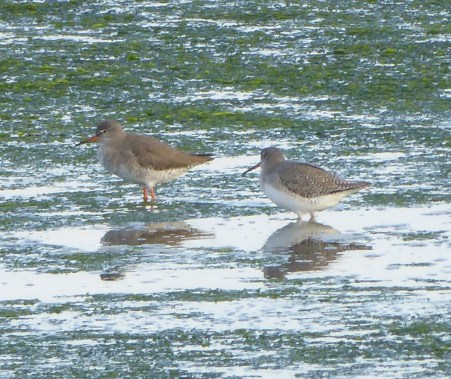
I managed to capture
part of the chase on a video clip.
See . . . https://youtu.be/QdoDgYgLbVw
I have witnessed many
incidents like today's usually involving the Spotted
Redshank and Common Redshank in previous years. I
guess it has something to do with protection of
feeding territory, though I recall many occasions
where the Spotted Redshank and Common Redshank
seemingly feed quite happily together. It will be
interesting to see if and when a second Spotted
Redshank turns up, as it frequently has done in the
past
White-tailed
Eagles to Isle of Wight?
There is a
plan to try and reintroduce White-tailed Eagles to the
Isle of Wight based on evidence that they used to
breed there 100s of years ago. Full story is here . .
. https://raptorpersecutionscotland.wordpress.com/2018/11/01/proposal-to-reintroduce-white-tailed-eagles-to-isle-of-wight/
Facts about the
White-tailed Eagle
It is the largest UK bird of prey. It has brown
body plumage with a conspicuously pale head and neck
which can be almost white in older birds, and the tail
feathers of adults are white. In flight it has massive
long, broad wings with 'fingered' ends. Its head
protrudes and it has a short, wedge-shaped tail.
Schedule 1 species it went extinct in the UK during
the early 20th century, due to illegal killing, and
the present population is descended from reintroduced
birds.
On the left is a
illustration showing its main features and on the
right a great shot by Steve Copsey at Downton showing
the enormous size of the bird in contrast to Buzzard
and Jackdaw.
The Hampshire
Ornithological Society is doing a poll of its members
on whether they support the idea. I have voted 'yes'
for the introduction as I think they would add an
interesting extra feature to the Island's ecology,
stimulate children's interest and boost 'eagle
tourism' as they have done on the Isles of Mull and
Skye where they have also been introduced.
The voting link . . . https://www.surveymonkey.com/r/LLGD9FT
For
the previous entries go to . . October
1-30